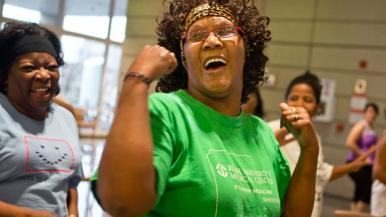Ditch the workout, join the party!
Zumba's company slogan promises exercise that doesn't feel like exercise. And the popularity of the Latin dance-inspired fitness program suggests that this concept has swayed more than a party's worth of people.
Kathy Weber, MD, MS, a sports medicine physician at Rush, is all for having fun while burning calories. But she cautions that forgetting yourself too thoroughly can lead to injuries.
"You think, 'It's just dance, it's fun, how am I going to get hurt dancing?' " Weber says. "And you want to get in shape, so you'll start going two or three times a week right away. But it's a high-intensity activity, and when you do too much too fast, you can get injured."
Here, Weber offers these four tips for avoiding that fate — whether you've chosen Zumba, salsa, cardio ballet or one of the many other ways to dance yourself into shape.
1. Treat it like any other exercise.
"Dance is like any other sport," says Weber, who serves as both a team physician for the Chicago Bulls and a consultant to Chicago's Hubbard Street and River North dance companies. "So the general principles of exercise apply. If you haven't done a dance class before, start slow, maybe with one class a week, and work your way up."
If you go too fast, you'll put yourself at higher risk for injuries, particularly to your hips, knees, shins or ankles, which tend to bear the brunt of a dance workout's impact.
2. Pay attention to your pain.
Of course, if you're just starting out, you probably won't be able to avoid some aches and pains as you begin to work muscles you haven't used much in a while. So how do you distinguish between problematic pain and normal soreness?
"If it's an acute injury — you twist your ankle, hear a pop, the ankle swells — that obviously needs to be seen by a doctor," Weber says.
Overuse injuries are more gradual. "You think, 'My hip is a little bothersome, so I'll rest, I'll take an over-the-counter painkiller and I'll be fine tomorrow,' " she explains. "But sometimes it just keeps progressing. Most soft tissue injuries usually improve within 10 to 14 days if they're going to get better; if it lasts longer than that, you should see your doctor."
Other signs that you need an evaluation include difficulty bearing weight, pain at night or pain that gets worse with activity.
You think, 'It's just dance, it's fun, how am I going to get hurt dancing?' But it's a high-intensity activity, and when you do too much too fast, you can get injured.
3. Stay strong and flexible.
Even if you go slowly, lack of strength or flexibility can put you at a higher risk of injury.
So however active you are, it's important to stretch. And if you do a lot of dance-based exercise, keeping your hips and legs strong is also crucial. Strength training for hips and legs can include working with weights, using resistance bands or doing exercises such as squats and lunges.
The best types of stretching or strength training for you will depend on your level of fitness and the rest of your exercise routine. For example, hamstring curls, leg lifts and step-ups might help protect you from knee pain caused by high-impact activities.
If you aren't sure what stretches or exercises you should do, ask your doctor if he or she will recommend an expert who can help figure out what will work for you.
4. Do what you like, but push yourself.
"I want my patients to have fun and stay active," Weber says. "And the way to stick with a routine is to find a type of exercise you like — that's why dance is great for a lot of people."
But don't get too comfortable.
"We tend to gravitate toward things that we're good at," Weber says. "If you're really flexible, you probably like to go to yoga. But sometimes we have to push ourselves a little bit to explore those things that are harder for us."
Pushing your comfort zone and varying your activities, she points out, is sometimes the only way to make sure you work a variety of muscles and include both strengthening and aerobic activity in your routine. The ideal is to find a middle ground: a routine that involves things that are hard, but that you still enjoy.




